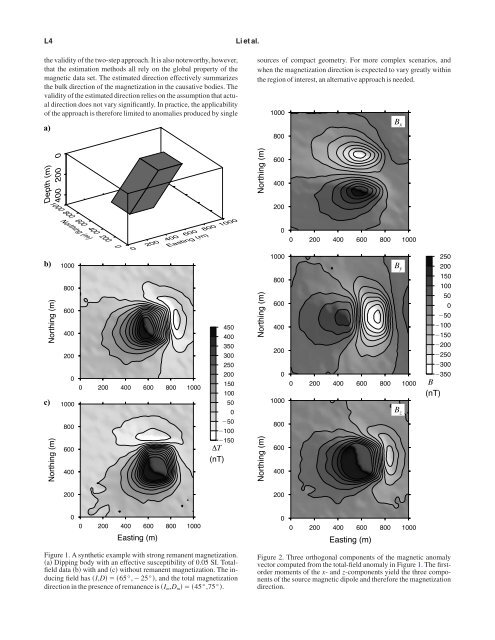Comprehensive approaches to 3D inversion of magnetic ... - CGISS
Comprehensive approaches to 3D inversion of magnetic ... - CGISS
Comprehensive approaches to 3D inversion of magnetic ... - CGISS
You also want an ePaper? Increase the reach of your titles
YUMPU automatically turns print PDFs into web optimized ePapers that Google loves.
L4<br />
Li et al.<br />
the validity <strong>of</strong> the two-step approach. It is also noteworthy, however,<br />
that the estimation methods all rely on the global property <strong>of</strong> the<br />
<strong>magnetic</strong> data set. The estimated direction effectively summarizes<br />
the bulk direction <strong>of</strong> the magnetization in the causative bodies. The<br />
validity <strong>of</strong> the estimated direction relies on the assumption that actual<br />
direction does not vary significantly. In practice, the applicability<br />
<strong>of</strong> the approach is therefore limited <strong>to</strong> anomalies produced by single<br />
a)<br />
sources <strong>of</strong> compact geometry. For more complex scenarios, and<br />
when the magnetization direction is expected <strong>to</strong> vary greatly within<br />
the region <strong>of</strong> interest, an alternative approach is needed.<br />
1000<br />
800<br />
B x<br />
Depth (m)<br />
400 200 0<br />
1000<br />
Northing (m)<br />
600<br />
400<br />
200<br />
b)<br />
Northing (m)<br />
c)<br />
Northing (m)<br />
800 600 400 200<br />
Northing (m)<br />
1000<br />
800<br />
600<br />
400<br />
200<br />
0<br />
1000<br />
800<br />
600<br />
400<br />
0<br />
0 200 400 600 800 1000<br />
Easting (m)<br />
0 200 400 600 800 1000<br />
T<br />
(nT)<br />
450<br />
400<br />
350<br />
300<br />
250<br />
200<br />
150<br />
100<br />
50<br />
0<br />
50<br />
100<br />
150<br />
Northing (m)<br />
Northing (m)<br />
0<br />
1000<br />
800<br />
600<br />
400<br />
200<br />
0<br />
1000<br />
800<br />
600<br />
400<br />
0 200 400 600 800 1000<br />
250<br />
B y<br />
200<br />
150<br />
100<br />
50<br />
0<br />
50<br />
100<br />
150<br />
200<br />
250<br />
300<br />
350<br />
0 200 400 600 800 1000 B<br />
(nT)<br />
B z<br />
200<br />
200<br />
0<br />
0 200 400 600 800 1000<br />
Easting (m)<br />
0<br />
0 200 400 600 800 1000<br />
Easting (m)<br />
Figure 1. A synthetic example with strong remanent magnetization.<br />
a Dipping body with an effective susceptibility <strong>of</strong> 0.05 SI. Totalfield<br />
data b with and c without remanent magnetization. The inducing<br />
field has I,D65°,25°, and the <strong>to</strong>tal magnetization<br />
direction in the presence <strong>of</strong> remanence is I m ,D m 45°,75°.<br />
Figure 2. Three orthogonal components <strong>of</strong> the <strong>magnetic</strong> anomaly<br />
vec<strong>to</strong>r computed from the <strong>to</strong>tal-field anomaly in Figure 1. The firs<strong>to</strong>rder<br />
moments <strong>of</strong> the x- and z-components yield the three components<br />
<strong>of</strong> the source <strong>magnetic</strong> dipole and therefore the magnetization<br />
direction.
















